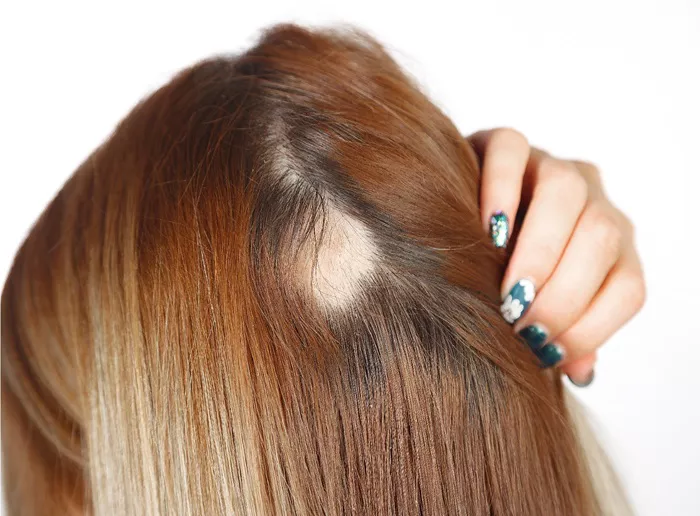Alopecia areata is an autoimmune disorder. It causes hair loss on the scalp, face, and sometimes other parts of the body. This condition can affect people of all ages and genders. Recognizing the symptoms early can help in managing the condition effectively.
16 Symptoms of Alopecia Areata
1. Sudden Hair Loss
Sudden hair loss is the most noticeable symptom of alopecia areata. It usually starts with small, round, smooth patches on the scalp or other hair-bearing areas of the body. This hair loss can occur over a few days or weeks.
Characteristics of Sudden Hair Loss
Patchy Hair Loss: The most common pattern is small, round patches of hair loss.
Smooth Scalp: The skin in the bald spots remains smooth and normal.
Hair loss occurs suddenly and progresses quickly.
2. Tingling or Itching Sensation
Many people with alopecia areata experience tingling or itching sensations before the hair falls out. This is an early warning sign that a new patch of hair loss may be developing.
Understanding the Sensations
Prickling Feeling: Some describe it as a prickling or burning sensation.
Localized Itching: Itching is often localized to the area where hair loss will occur.
3. Hair Thinning
Hair thinning, or diffuse alopecia areata, is a less common symptom where hair becomes noticeably thinner across the scalp without forming distinct bald patches.
Details of Hair Thinning
Overall Reduction: General thinning without clear bald spots.
Gradual Process: Thinning may occur gradually and is less dramatic than patchy hair loss.
4. Changes in Hair Texture
Hair that regrows in affected areas may have a different texture or color. It might appear fine, white, or gray initially before returning to its usual color and texture.
Types of Changes
Fine and Soft Hair: Regrown hair may be finer and softer than normal.
Color Changes: Hair may grow back white or gray before regaining its natural color.
5. Exclamation Mark Hairs
Exclamation mark hairs are short, broken hairs that taper at the base, resembling an exclamation mark. These are typically found at the edges of bald patches.
Identifying Exclamation Mark Hairs
Short Length: These hairs are usually only a few millimeters long.
Tapered Base: The base of the hair shaft is thinner than the top.
See also: 10 Common Causes of Hair Loss in Your 20s
6. Nail Changes
Alopecia areata can also affect the fingernails and toenails. Changes may include pitting, ridges, or a rough texture.
Common Nail Changes
Pitting: Tiny dents appear on the nail surface.
Ridges: Lines running across the nails.
Brittleness: Nails may become thin and brittle.
7. Eyelash and Eyebrow Loss
In some cases, alopecia areata can cause hair loss in the eyebrows and eyelashes, affecting facial appearance.
Impact on Facial Hair
Sparse Eyebrows: Partial or complete loss of eyebrow hair.
Thinning Eyelashes: Loss of eyelashes can affect eye protection.
8. Body Hair Loss
Alopecia areata can affect body hair, including hair on the arms, legs, and other areas.
Pattern of Body Hair Loss
Patchy Loss: Similar to scalp hair loss, body hair loss can occur in patches.
Complete Loss: In severe cases, all body hair may be lost (alopecia universalis).
9. Emotional and Psychological Impact
Hair loss can have significant emotional and psychological effects. Feelings of self-consciousness, anxiety, and depression are common among those affected.
Emotional Symptoms
Low Self-Esteem: Impact on self-image and confidence.
Social Anxiety: Fear of social situations due to appearance changes.
10. Scalp Discomfort
Some individuals experience discomfort or tenderness in the areas where hair loss occurs.
Types of Discomfort
Tenderness: The scalp may feel tender to the touch.
Sensitivity: Increased sensitivity in the affected areas.
11. Regrowth Cycles
Hair may fall out and regrow in cycles, with periods of growth followed by renewed hair loss.
Understanding Regrowth Cycles
Temporary Regrowth: Hair may grow back temporarily and then fall out again.
Variable Duration: The length of these cycles can vary widely.
12. Oval or Round Bald Patches
The classic presentation of alopecia areata involves the appearance of oval or round bald patches on the scalp or other hair-bearing areas.
Characteristics of Bald Patches
Defined Edges: Bald patches usually have well-defined edges.
Variable Size: The size of the patches can vary from small to large.
13. Total Scalp Hair Loss
In some cases, alopecia areata progresses to alopecia totalis, which is the complete loss of all scalp hair.
Impact of Total Scalp Hair Loss
Complete Baldness: No hair remains on the scalp.
Increased Psychological Impact: More severe emotional and psychological effects.
14. Sudden Regrowth
Sudden regrowth of hair in previously bald areas is also a symptom. This hair may initially appear different in texture or color.
Features of Sudden Regrowth
Unexpected Growth: Hair may start growing back without warning.
Different Texture: Initially, the new hair may be fine or white.
15. Hair Loss in Circular Patterns
In some cases, the hair loss occurs in distinct circular patterns rather than irregular patches.
Pattern Characteristics
Circular Bald Spots: Bald areas are circular and evenly spaced.
Symmetrical Patterns: Often symmetrical on both sides of the scalp.
16. Concurrent Autoimmune Disorders
Alopecia areata is associated with other autoimmune disorders. Those affected may also experience symptoms of other conditions like thyroid disease, vitiligo, or lupus.
Common Concurrent Disorders
Thyroid Disease: Symptoms of hypo- or hyperthyroidism.
Vitiligo: Loss of skin pigmentation in patches.
Lupus: Joint pain, fatigue, and skin rashes.
Conclusion
Alopecia areata presents a wide range of symptoms that can vary significantly from person to person. Recognizing these symptoms early can help in seeking appropriate treatment and support. While the physical effects of hair loss are the most visible, the emotional and psychological impact is also profound. It is essential for individuals experiencing alopecia areata to seek comprehensive care that addresses both the physical and emotional aspects of the condition.
You May Be Interested In

